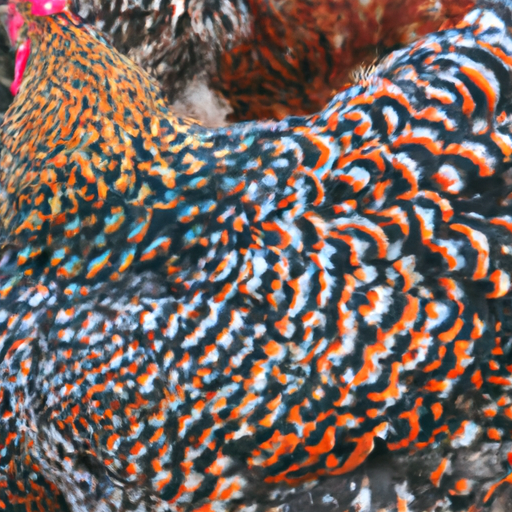Managing mixed-breed flocks can be an exciting and rewarding endeavor, but it also presents unique challenges. As you embark on your journey of tending to a diverse group of feathered friends, you may find yourself wondering if there are any tried and tested methods to ensure the harmonious coexistence of different breeds. In this article, we will explore the potential advantages, considerations, and best practices for successfully managing mixed-breed flocks. Whether you are a seasoned poultry enthusiast or just starting out, join us as we discover the wonderful world of raising a diverse flock!
Introduction
Managing a mixed-breed flock can be an exciting and rewarding experience for poultry owners. By raising different breeds together, you can benefit from enhanced genetic diversity, reduced risk of disease, and improved flock performance. However, there are also challenges to consider, such as potential breeding complications, variable performance and traits, and increased labor and management. In this comprehensive article, we will explore the benefits and challenges of managing mixed-breed flocks, as well as provide guidance on establishing and maintaining a mixed-breed flock, feed management, housing and space considerations, health care, breeding and reproduction management, managing behavior and social interactions, and market considerations.
Benefits of Mixed-Breed Flocks
Enhanced Genetic Diversity
One of the primary advantages of raising mixed-breed flocks is the enhanced genetic diversity it offers. By introducing different breeds into your flock, you can promote genetic heterogeneity, which can lead to healthier and more adaptable birds. Genetic diversity helps minimize the risk of inbreeding, which can result in reduced fertility and increased susceptibility to diseases. With mixed-breed flocks, you can ensure that your poultry population remains robust and resilient.
Reduced Risk of Disease
Raising a single breed flock can make your birds more susceptible to diseases. However, by incorporating mixed breeds, you enhance the chances of having diverse immune systems in your flock. This genetic variation can increase resistance to specific diseases, reducing the risk of an entire flock succumbing to one pathogen. Moreover, if a disease does affect one particular breed, the other breeds may still remain healthy, reducing the overall economic impact on your farm.
Improved Flock Performance
Mixed-breed flocks often exhibit improved overall performance compared to single breed flocks. Different breeds may excel in various traits, including egg production, meat quality, or adaptability to different climates. By combining these strengths, you can create a flock that showcases the best qualities of each breed. This can lead to higher productivity, better egg or meat yields, and increased profitability for your poultry operation.
Challenges of Managing Mixed-Breed Flocks
Potential Breeding Complications
When managing a mixed-breed flock, there is a possibility of breeding complications. Certain breeds may have different mating behaviors or reproductive cycles, making successful breeding more challenging. It is important to thoroughly research and understand the breeding characteristics of each breed in your flock to ensure compatibility and minimize breeding difficulties. Additionally, you may encounter difficulties in securing purebred offspring if you intend to maintain breed purity within certain breeds of your mixed flock.
Variable Performance and Traits
With mixed-breed flocks, there can be variations in performance and traits among individual birds. Each breed brings its own set of unique characteristics, which may lead to differences in growth rates, egg production, or temperament. This can make it challenging to maintain consistent flock performance and to predict the traits of individual birds. Monitoring and managing these variations require extra attention and adjustment to optimize the overall performance and productivity of the flock.
Increased Labor and Management
Managing mixed-breed flocks can require additional labor and management compared to single breed flocks. The different needs, behaviors, and characteristics of various breeds may necessitate more attentive care, including customized feeding, housing, and health management practices. Extra effort is needed to ensure that each breed in the flock receives appropriate attention, resulting in increased time and resources spent on flock management.
Establishing and Maintaining a Mixed-Breed Flock
Selecting Compatible Breeds
Choosing compatible breeds is crucial when establishing a mixed-breed flock. Consider factors such as temperament, size, and production traits. Ensure that the breeds you select can coexist harmoniously and have similar nutritional requirements. It is also important to choose breeds that complement each other in terms of egg production, meat quality, or adaptability to the local environment. Thorough research and consultation with experienced breeders can guide you in making well-informed decisions.
Introducing New Breeds to the Flock
Introducing new breeds to an existing mixed-breed flock requires careful planning and management. Quarantine new birds to prevent the spread of diseases and allow for observation of their health status. Gradually introduce them to the existing flock, providing a separate area for them to acclimate before integrating with the other birds. Monitoring their behavior during this period is essential to ensure a smooth transition and minimize aggression or stress.
Monitoring Behavior and Hierarchies
In a mixed-breed flock, establishing and maintaining a harmonious social hierarchy is critical for flock dynamics. It is natural for different breeds to have varying degrees of dominance or submissiveness. Monitor the behavior of individual birds and intervene if aggressive behaviors become problematic. Providing sufficient space, enrichment, and resources can help alleviate tensions and promote healthy social interactions among the different breeds in the flock.
Feed Management for Mixed-Breed Flocks
Nutritional Requirements for Different Breeds
Managing a mixed-breed flock also involves understanding and catering to the varying nutritional requirements of each breed. Different breeds may have specific dietary needs based on their growth rate, size, or production traits. Consult with a poultry nutritionist or veterinarian to develop a feeding program that meets the specific requirements of each breed in your flock. Monitoring the body condition and performance of the birds can help ensure that they receive the appropriate nutrients for their optimal health and productivity.
Feeding Strategies and Rations
When feeding a mixed-breed flock, it is important to consider the logistics of feeding and implement appropriate strategies to ensure all birds receive adequate nutrition. Depending on the number and size of breeds in your flock, it may be necessary to provide separate feeding stations or utilize feeder designs that allow for easy access by different-sized birds. Developing feeding rations that meet the nutritional needs of all the breeds in your flock is essential for maintaining their overall health and performance.
Monitoring Feed Consumption
Regularly monitoring feed consumption is crucial when managing a mixed-breed flock. Keep track of how much feed each breed consumes to ensure that all birds are receiving their fair share. This information is valuable in identifying any health or performance issues within specific breeds and allows for adjustments in feeding strategies if necessary. By closely monitoring feed consumption, you can identify deviations from the norm and address any potential problems before they escalate.
Housing and Space Considerations
Providing Adequate Shelter
Proper housing is essential for the well-being and productivity of a mixed-breed flock. Ensure that the housing facilities are spacious, well-ventilated, and secure. Consider the sizes and space requirements of each breed, providing ample room for movement, perching, nesting, and dust bathing. Proper insulation and ventilation are crucial for maintaining optimal environmental conditions and disease prevention. Regular cleaning and sanitization of the housing facilities are necessary to minimize the spread of diseases and parasites.
Understanding Space Requirements
Different breeds may have varying spatial requirements. Some breeds may be more active and require more space for exercise, while others may be more sedentary. Understanding the space needs of each breed is essential for providing appropriate living conditions. Monitor how the birds utilize the available space and make adjustments if necessary to ensure adequate living and roaming areas for each breed.
Separating Breeds, if Necessary
In certain cases, separating breeds within the flock may be necessary. Some aggressive or dominant breeds may pose a threat to more docile or smaller breeds. If conflicts arise that compromise the safety and well-being of specific breeds, consider providing separate housing or designated areas within the housing facility. This allows for more effective management of the different breeds, ensuring their safety and minimizing stress or injuries.
Health Care for Mixed-Breed Flocks
Vaccination Protocols
Implementing a proactive vaccination program is crucial for the health and disease prevention of mixed-breed flocks. Consult with a veterinarian to determine the appropriate vaccination protocols for each breed in your flock, taking into account their specific disease susceptibility and regional disease risks. Adherence to a well-designed vaccination schedule can greatly reduce the incidence and impact of infectious diseases, safeguarding the health and productivity of your mixed-breed flock.
Regular Veterinary Check-ups
Routine veterinary check-ups are vital for maintaining the overall health of your mixed-breed flock. Establish a relationship with a knowledgeable poultry veterinarian who can provide regular health examinations, identify potential health issues, and offer guidance on preventive measures and treatments. Regular check-ups allow for early detection and prompt management of any emerging health concerns, helping to prevent the spread of diseases and ensuring the longevity of your mixed-breed flock.
Disease Prevention and Biosecurity Measures
Effective disease prevention and biosecurity practices are critical for managing mixed-breed flocks. Establish biosecurity protocols to minimize the introduction and spread of diseases, including strict sanitation measures, controlled flock access, and quarantine procedures for new birds. Regularly monitor and evaluate biosecurity measures to identify areas for improvement and mitigate potential disease risks. By implementing robust disease prevention strategies, you can protect the health and productivity of your mixed-breed flock.
Breeding and Reproduction Management
Breeding Programs and Goals
When breeding mixed-breed flocks, it is important to have clear breeding programs and goals. Determine the purpose of your breeding efforts, whether it is to maintain and improve specific traits, develop new hybrid vigor, or preserve breed purity. Select breeding birds based on their desired traits and carefully manage the mating process to optimize genetic diversity and maintain breed characteristics. Regularly evaluate the breeding outcomes and adjust your breeding program as needed to achieve your goals.
Maintaining Breeding Records
Maintaining detailed breeding records is essential for managing mixed-breed flocks. Track breeding pairs, hatch rates, chick growth, and any notable characteristics or performances. This information enables you to make informed decisions when selecting breeding stock, identify any genetic or reproductive issues, and monitor the overall progression of your breeding program. Accurate and organized breeding records are invaluable for maintaining lineage integrity and making strategic breeding decisions.
Considerations for Crossbreeding
Crossbreeding can be a valuable strategy in managing mixed-breed flocks. It allows for the creation of hybrid vigor, combining desirable traits from different breeds. Carefully select the breeds to cross, considering their complementary characteristics and objectives. Keep in mind that crossbreeding can sometimes lead to unpredictable results, so a systematic approach with thorough documentation and evaluation is crucial to achieve desired outcomes. Crossbreeding can bring exciting opportunities for enhancing performance and adaptability within your mixed-breed flock.
Managing Behavior and Social Interactions
Dominance and Pecking Order
Understanding and managing social hierarchies within mixed-breed flocks is essential for minimizing aggression and ensuring a harmonious environment. Recognize that different breeds may have varying dominance behaviors and tendencies. Monitor flock dynamics and intervene if aggressive behaviors become excessive or endanger the well-being of individual birds. Providing adequate space, multiple feeding stations, and enrichments can help mitigate aggression and establish a balanced pecking order.
Integrating New Birds
When introducing new birds to a mixed-breed flock, careful integration is necessary. Gradually introduce new birds to the existing flock by allowing them visual contact while still providing physical separation. Observe the interactions between birds and monitor for signs of aggression or stress. If needed, separate aggressive individuals or provide distractions and enrichments to redirect their focus. Patience and gradual integration are key to successfully incorporating new birds into the existing flock.
Providing Enrichment and Mental Stimulation
Ensuring mental stimulation and enrichment activities are essential for the overall well-being and behavior of mixed-breed flocks. Different breeds may have varying activity levels and interests, so providing a range of activities can prevent boredom and aggression. Enrichments can include perches, dust bathing areas, toys, and environmental enhancements such as foraging opportunities or obstacle courses. These enrichments promote natural behaviors, minimize stress, and enhance the mental and physical health of your mixed-breed flock.
Market Considerations for Mixed-Breed Flocks
Targeting Niche Markets
Managing mixed-breed flocks can open up opportunities to target niche markets. Different breeds may possess unique attributes that appeal to specific consumer preferences, such as heritage, meat quality, or egg color. Research and identify niche markets that value or require the characteristics offered by your mixed-breed flock. By targeting these markets, you can differentiate your products and potentially command higher prices, enhancing the profitability of your poultry operation.
Marketing Strategies and Branding
Developing effective marketing strategies and branding for your mixed-breed flock products is crucial for success. Clearly communicate the attributes, benefits, and stories behind the mixed breeds in your flock to attract and engage customers. Utilize various marketing platforms, such as social media, local markets, or specialty stores, to reach targeted audiences. Establishing a recognizable brand identity can create customer loyalty and generate interest in your unique mixed-breed flock products.
Pricing and Consumer Education
When pricing your mixed-breed flock products, consider factors such as production costs, market demand, and the perceived value of the unique breed combinations. Conduct market research to determine a pricing strategy that is competitive yet reflective of the quality and uniqueness of your products. Additionally, invest in consumer education initiatives to raise awareness about the advantages and attributes of your mixed-breed flock. Educated consumers are more likely to appreciate and value the products you offer, supporting your market presence and long-term success.
In conclusion, managing mixed-breed flocks offers a range of benefits, including enhanced genetic diversity, reduced disease risk, and improved flock performance. However, it also presents challenges such as potential breeding complications, variable performance and traits, and increased labor and management. By carefully selecting compatible breeds, implementing appropriate feed management, providing suitable housing and space, ensuring comprehensive health care, managing breeding and reproduction, promoting positive behavior and social interactions, and capitalizing on market considerations, you can successfully navigate and optimize the management of your mixed-breed flock. With proper planning, knowledge, and dedication, a mixed-breed flock can provide a rewarding and prosperous poultry operation.




